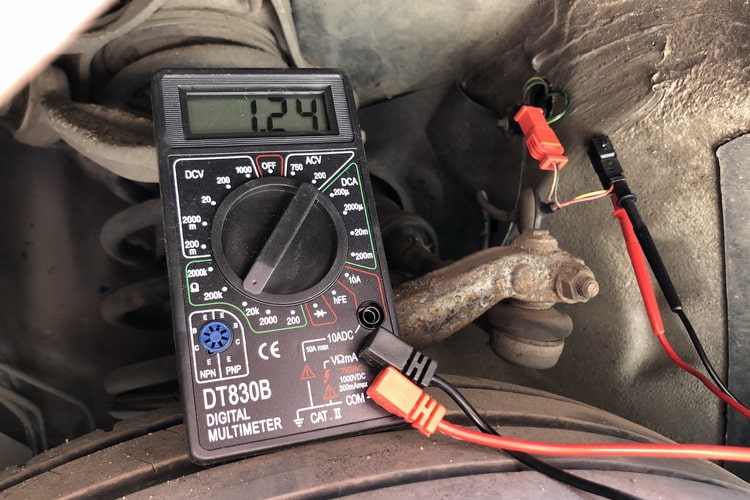
How to check the ABS sensor for performance
Content
The presence of ABS in the vehicle at times increases traffic safety. Gradually, car parts wear out and may become unusable. Knowing how to check the ABS sensor, the driver can identify and fix the problem in time without resorting to the services of a car repair shop.
Content
- 1 How the ABS works on a car
- 2 ABS device
- 3 Basic views
- 3.1 Passive
- 3.2 magnetoresistive
- 3.3 Based on the Hall element
- 4 Causes and symptoms of malfunctions
- 5 How to check the ABS sensor
- 5.1 Tester (multimeter)
- 5.2 Oscilloscope
- 5.3 Without appliances
- 6 Sensor repair
- 6.1 Video: how to repair an ABS sensor
- 7 Wiring repair
How the ABS works on a car
Anti-lock braking system (ABS, ABS; English. Anti-lock braking system) is designed to prevent blocking of the car wheels.
The primary task of ABS is preservation control over the machine, its stability and controllability during unforeseen braking. This allows the driver to make a sharp maneuver, which significantly increases the active safety of the vehicle.
Since the coefficient of friction is reduced in relation to the coefficient of rest, the car will cover a much greater distance when braking on locked wheels than on rotating wheels. In addition, when the wheels are blocked, the car carries a skid, depriving the driver of the chance to carry out any maneuver.
The ABS system is not always effective. On an unstable surface (loose soil, gravel, snow or sand), immobilized wheels form a barrier from the surface in front of them, breaking into it. This significantly reduces the braking distance. A car with studded tires on ice when the ABS is activated will travel a greater distance than with locked wheels. This is due to the fact that the rotation prevents the spikes, crashing into the ice, to slow down the movement of vehicles. But at the same time, the car retains controllability and stability, which in most cases is much more important.
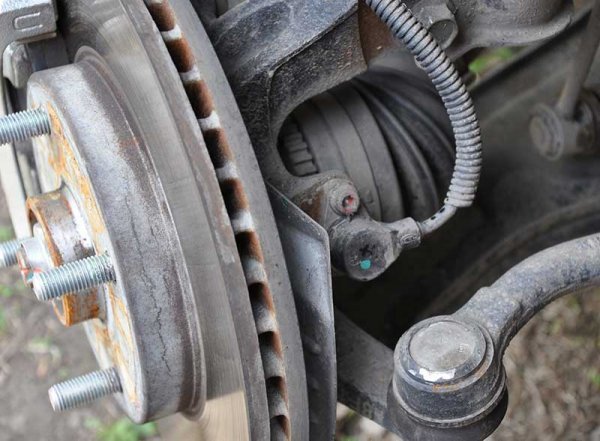
Wheel speed sensors mounted on the hubs
The equipment installed on individual vehicles allows the function of disabling the ABS.
It is interesting! Experienced drivers on cars that are not equipped with an anti-lock device, when unexpected braking on a difficult section of the road (wet asphalt, ice, snow slurry), act on the brake pedal jerkily. In this way, they avoid complete wheel lockup and prevent the car from skidding.
ABS device
The anti-lock device consists of several nodes:
- Speed meters (acceleration, deceleration);
- Control magnetic dampers, which are part of the pressure modulator and located in the line of the braking system;
- Electronic monitoring and control system.
The pulses from the sensors are sent to the control unit. In the event of an unexpected decrease in speed or a complete stop (blocking) of any wheel, the unit sends a command to the desired damper, which lowers the pressure of the fluid that enters the caliper. Thus, the brake pads are weakened, and the wheel resumes movement. When the wheel speed equalizes with the rest, the valve closes and the pressure in the entire system equalizes.
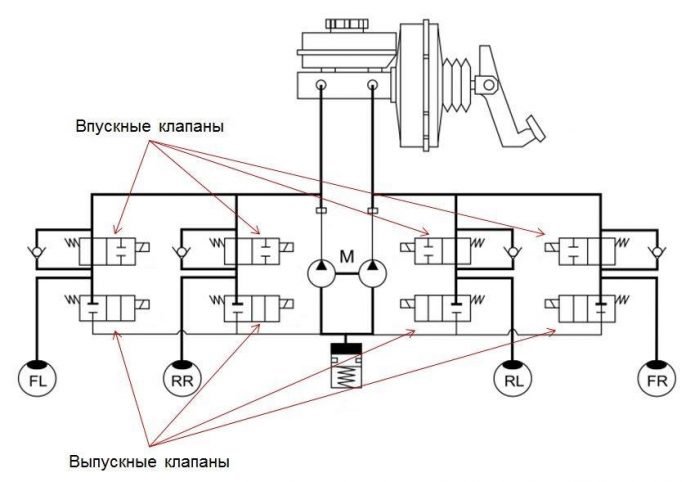
General view of the ABS system in the car
On newer vehicles, the anti-lock braking system is triggered up to 20 times per second.
The ABS of some vehicles includes a pump, the function of which is to quickly increase the pressure in the desired section of the highway to normal.
It is interesting! The action of the anti-lock braking system is felt by reverse shocks (blows) on the brake pedal with strong pressure on it.
By the number of valves and sensors, the device is divided into:
- Single channel. The sensor is located near the differential on the rear axle. If even one wheel stops, the valve lowers the pressure on the entire line. Found only on older cars.
- Dual channel. Two sensors are located on the front and rear wheels diagonally. One valve is connected to the line of each bridge. It is not used in cars manufactured according to modern standards.
- Three-channel. Speed meters are located on the front wheels and rear axle differential. Each has a separate valve. It is used in budget rear-wheel drive models.
- Four-channel. Each wheel is equipped with a sensor and its rotation speed is controlled by a separate valve. Installed on modern cars.
Basic views
ABS sensor withis read by the paramount measuring part of the anti-lock braking system.
The device consists of:
- A meter placed permanently near the wheel;
- Induction ring (rotation indicator, impulse rotor) mounted on the wheel (hub, hub bearing, CV joint).
Sensors are available in two versions:
- Straight (end) cylindrical shape (rod) with an impulse element at one end and a connector at the other;
- Angled with a connector on the side and a metal or plastic bracket with a hole for a mounting bolt.
There are two types of sensors available:
- Passive - inductive;
- Active - magnetoresistive and based on the Hall element.
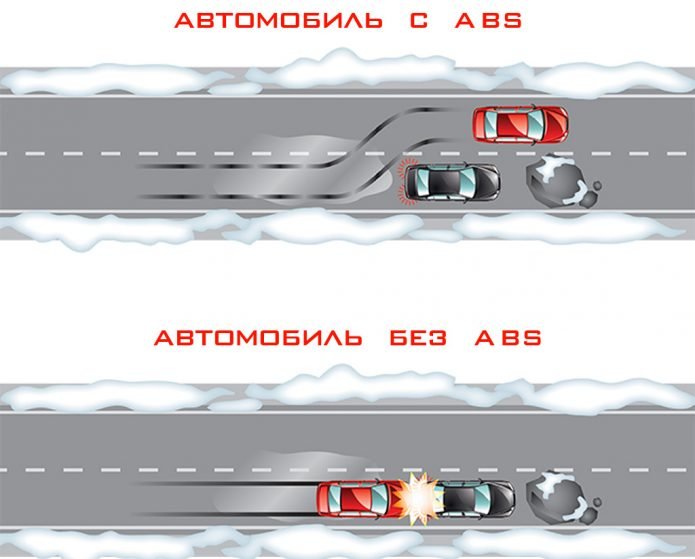
ABS allows you to maintain controllability and significantly increase stability during emergency braking
Passive
They are distinguished by a simple system of work, while they are quite reliable and have a long service life. Does not need to be connected to power. An inductive sensor is essentially an induction coil made of copper wire, in the middle of which is a stationary magnet with a metal core.
The meter is located with its core to the impulse rotor in the form of a wheel with teeth. There is a certain gap between them. The teeth of the rotor are rectangular in shape. The gap between them is equal to or slightly more than the width of the tooth.
While the transport is in motion, as the teeth of the rotor pass near the core, the magnetic field penetrating through the coil is constantly changing, forming an alternating current in the coil. The frequency and amplitude of the current are directly dependent on the speed of the wheel. Based on the processing of this data, the control unit issues a command to the solenoid valves.
The disadvantages of passive sensors are:
- Relatively large dimensions;
- Weak accuracy of indications;
- They begin to function when the car speeds up more than 5 km / h;
- They work with minimal rotation of the wheel.
Due to frequent errors on modern cars, they are extremely rarely installed.
magnetoresistive
The work is based on the property of ferromagnetic materials to change electrical resistance when exposed to a constant magnetic field.
The part of the sensor that controls changes is made of two or four layers of iron-nickel plates with conductors deposited on them. Part of the element is installed in an integrated circuit that reads changes in resistance and forms a control signal.
The impulse rotor, which is a magnetized plastic ring in places, is rigidly fixed to the wheel hub. During operation, the magnetized sections of the rotor change the medium in the plates of the sensitive element, which is fixed by the circuit. At its output, pulse digital signals are generated that enter the control unit.
This type of device controls the speed, the course of rotation of the wheels and the moment of their complete stop.
Magneto-resistive sensors detect changes in the rotation of the vehicle's wheels with great accuracy, increasing the effectiveness of safety systems.
Based on the Hall element
This type of ABS sensor operates based on the Hall effect. In a flat conductor placed in a magnetic field, a transverse potential difference is formed.
Hall effect - the appearance of a transverse potential difference when a conductor with direct current is placed in a magnetic field
This conductor is a square-shaped metal plate placed in a microcircuit, which includes a Hall integrated circuit and a control electronic system. The sensor is located on the opposite side of the impulse rotor and has the form of a metal wheel with teeth or a plastic ring in places magnetized, rigidly fixed to the wheel hub.
The Hall circuit continuously generates signal bursts of a certain frequency. At rest, the frequency of the signal is reduced to a minimum or stops completely. During movement, magnetized areas or teeth of the rotor passing by the sensing element cause current changes in the sensor, fixed by the tracking circuit. Based on the received data, an output signal is generated that enters the control unit.
Sensors of this type measure the speed from the beginning of the movement of the machine, they are distinguished by the accuracy of measurements and the reliability of functions.
Causes and symptoms of malfunctions
In new generation cars, when the ignition is turned on, an automatic self-diagnosis of the anti-lock braking system takes place, during which the performance of all its elements is assessed.
Evidence | Possible reasons |
Self-diagnosis shows an error. ABS is disabled. | Incorrect operation of the control unit. Break in the wire from the sensor to the control unit. |
Diagnostics does not find errors. ABS is disabled. | Violation of the integrity of the wiring from the control unit to the sensor (break, short circuit, oxidation). |
Self-diagnosis gives an error. ABS works without turning off. | Break in the wire of one of the sensors. |
ABS does not turn on. | Break in the power supply wire of the control unit. Chips and fractures of the impulse ring. Lots of play on a worn hub bearing. |
In addition to the display of light indications on the dashboard, there are the following signs of a malfunction of the ABS system:
- When pressing the brake pedal, there is no reverse knocking and vibration of the pedal;
- During emergency braking, all wheels are blocked;
- The speedometer needle shows a speed less than the actual speed or does not move at all;
- If more than two gauges fail, the parking brake indicator lights up on the instrument panel.
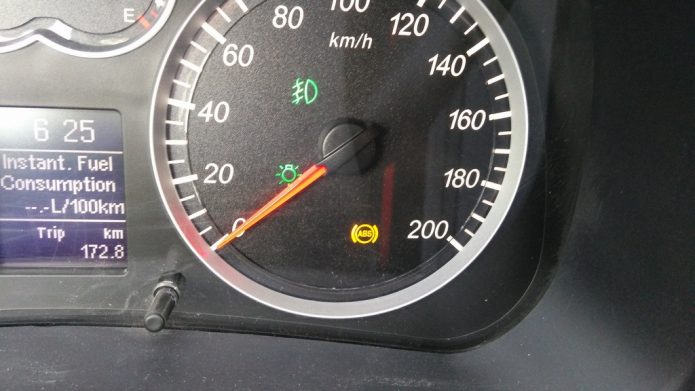
In the event of a malfunction of the anti-lock braking system, a warning lamp lights up on the dashboard
The reasons for the inefficient operation of the ABS can be:
- Failure of one or more speed sensors;
- Damage to the wiring of the sensors, which entails unstable signal transmission to the control module;
- A voltage drop at the battery terminals below 10,5 V leads to the shutdown of the ABS system.
How to check the ABS sensor
You can check the health of the speed sensor by contacting a car service specialist, or by yourself:
- Without special devices;
- Multimeter;
- Oscilloscope.
Tester (multimeter)
In addition to the measuring device, you will need a description of the functionality of this model. The sequence of work performed:
- The car is installed on a platform with a smooth, uniform surface, fixing its position.
- The wheel is dismantled for free access to the sensor.
- The plug used for connection is disconnected from the general wiring and cleaned of dirt. The rear wheel connectors are located at the rear of the passenger compartment. To ensure unhindered access to them, you need to remove the rear seat cushion and move the carpet with soundproofing mats.
- Conduct a visual inspection of the connecting wires for the absence of abrasions, breaks and violation of the insulation.
- The multimeter is set to ohmmeter mode.
- The sensor contacts are connected to the probes of the device and the resistance is measured. The rate of indications can be found in the instructions. If there is no reference book, then readings from 0,5 to 2 kOhm are taken as the norm.
- The wiring harness must be ringed in order to exclude the possibility of a short circuit.
- To confirm that the sensor is working, scroll the wheel and monitor the data from the device. The resistance reading changes as the rotation speed increases or decreases.
- Switch the instrument to voltmeter mode.
- When the wheel moves at a speed of 1 rpm, the voltage should be 0,25-0,5 V. As the rotation speed increases, the voltage should increase.
- Observing the stages, check the remaining sensors.
It is important! The design and resistance values of the sensors on the front and rear axles are different.

Resistance from 0,5 to 2 kOhm at the ABS sensor terminals is considered optimal
According to the measured resistance indicators, the operability of the sensors is determined:
- The indicator is reduced compared to the norm - the sensor is faulty;
- Resistance tends to or corresponds to zero - interturn circuit in the induction coil;
- Change of resistance data when bending the wiring harness - damage to the wire strands;
- The resistance tends to infinity - a wire break in the sensor harness or induction coil.
It is important! If, after monitoring the functions of all sensors, the resistance index of any of them differs significantly, this sensor is faulty.
Before checking the wiring for integrity, you need to find out the pinout of the control module plug. Thereafter:
- Open the connections of the sensors and the control unit;
- According to the pinout, all the wire harnesses ring in turn.
Oscilloscope
The device allows you to more accurately determine the performance of the ABS sensor. According to the graph of the signal change, the magnitude of the pulses and their amplitude are tested. Diagnostics is carried out on a car without removing the system:
- Disconnect the device connector and clean it of dirt.
- The oscilloscope is connected to the sensor through the pins.
- The hub is rotated at a speed of 2-3 rpm.
- Fix the signal change schedule.
- In the same way, check the sensor on the other side of the axle.
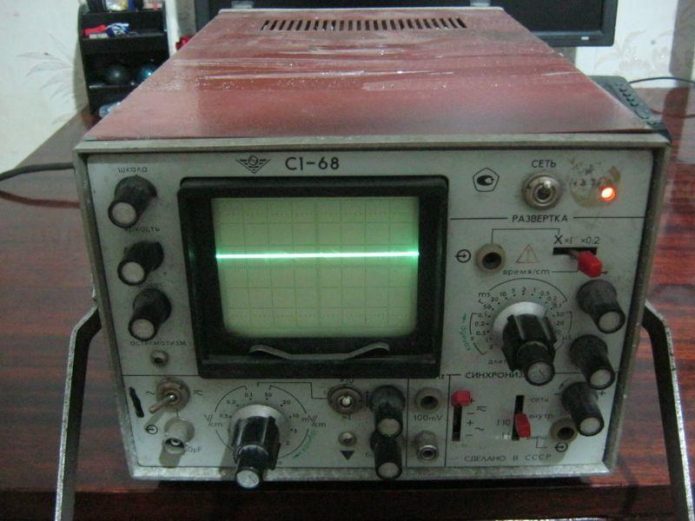
The oscilloscope gives the most complete picture of the operation of the anti-lock braking system sensor
Sensors are OK if:
- The recorded amplitudes of signal fluctuations on the sensors of one axis are identical;
- The graph curve is uniform, without visible deviations;
- The amplitude height is stable and does not exceed 0,5 V.
Without appliances
The correct operation of the sensor can be determined by the presence of a magnetic field. Why any object made of steel is applied to the sensor body. When the ignition is turned on, it should be attracted.
In addition, it is necessary to inspect the sensor housing for its integrity. Wiring should not show scuffs, insulation breaks, oxides. The connecting plug of the sensor must be clean, the contacts are not oxidized.
It is important! Dirt and oxides on the contacts of the plug can cause distortion of the signal transmission.
Sensor repair
A failed passive ABS sensor can be repaired by yourself. This requires perseverance and mastery of tools. If you doubt your own abilities, it is recommended to replace the faulty sensor with a new one.
Repair is carried out in the following sequence:
- The sensor is carefully removed from the hub. The soured fixing bolt is unscrewed, having previously been treated with WD40 liquid.
- The protective case of the coil is sawn with a saw, trying not to damage the winding.
- The protective film is removed from the winding with a knife.
- The damaged wire is unwound from the coil. The ferrite core is shaped like a spool of thread.
- For a new winding, you can use copper wire from RES-8 coils. The wire is wound so that it does not protrude beyond the dimensions of the core.
- Measure the resistance of the new coil. It must match the parameter of a working sensor located on the other side of the axle. Lower the value by unwinding a few turns of wire from the spool. To increase the resistance, you will have to rewind the wire of greater length. Fix the wire with adhesive tape or tape.
- Wires, preferably stranded, are soldered to the ends of the winding to connect the coil to the bundle.
- The coil is placed in the old housing. If it is damaged, then the coil is filled with epoxy resin, having previously placed it in the center of the housing from the capacitor. It is necessary to fill the entire gap between the coil and the walls of the condenser with glue so that air voids do not form. After the resin has hardened, the body is removed.
- The sensor mount is fixed with epoxy resin. It also treats the cracks and voids that have arisen.
- The body is brought to the required size with a file and sandpaper.
- The repaired sensor is installed in its original place. The gap between the tip and the gear rotor with the help of gaskets is set within 0,9-1,1 mm.
After installing the repaired sensor, the ABS system is diagnosed at different speeds. Sometimes, before stopping, spontaneous operation of the system occurs. In this case, the working gap of the sensor is corrected with the help of spacers or grinding of the core.
It is important! Faulty active speed sensors cannot be repaired and must be replaced with new ones.
Video: how to repair an ABS sensor
Wiring repair
Damaged wiring can be replaced. For this:
- Disconnect the wire plug from the control unit.
- Draw or photograph the layout of the wiring brackets with distance measurements.
- Unscrew the mounting bolt and dismantle the sensor with wiring, after removing the mounting brackets from it.
- Cut off the damaged section of the wire, taking into account the length margin for soldering.
- Remove protective covers and staples from the cut cable.
- Covers and fasteners are put on a wire pre-selected according to the outer diameter and cross section with a soapy solution.
- Solder the sensor and connector to the ends of the new harness.
- Isolate soldering points. The accuracy of the signals transmitted by the sensor and the service life of the repaired wiring section depend on the quality of the insulation.
- The sensor is installed in place, the wiring is positioned and fixed according to the diagram.
- Check the operation of the system in different speed modes.


The soldering point must be insulated with high quality to increase the accuracy of the transmitted signals
The safety of road users depends on the efficiency of the anti-lock braking system. If desired, the diagnosis and repair of ABS sensors can be carried out independently, without resorting to the services of a car service.